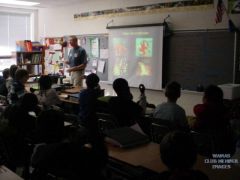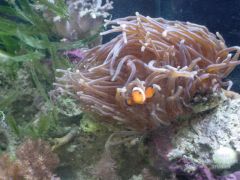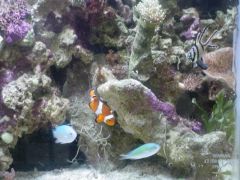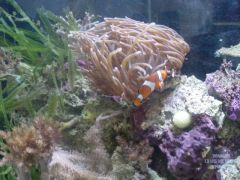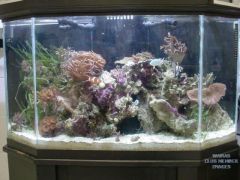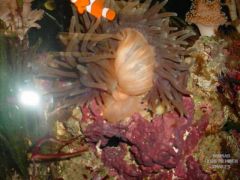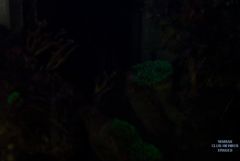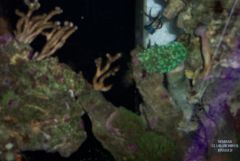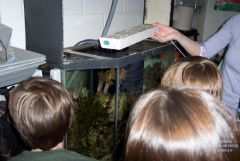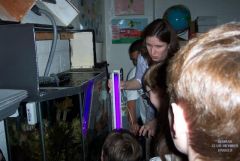-
Posts
65 -
Joined
-
Last visited
Content Type
Profiles
Forums
Gallery
Events
Store
Everything posted by Cedarlane
-
Here is a picture of what the sea anemone does when the lights go off. He twists his body around several times. Finally... new pictures of the tank from this year!
-
From the album: Cedar Lane
This is what the sea anemone has been doing when the lights go out. He twists his body around. -
I took the advice and got a little wet. I plucked the Valonia algae from the bottom of the tank and showed it to the kids. They all felt it and were surprised at how slick and hard it felt. We decided to cut it open to see what was inside. All we had in the classroom was a ruler, so I pressed down on it with the edge of the ruler until I punctured the skin. When it finally opened all that was inside was liquid, and the skin quickly shriveled up into an empty sac. We were surprised at how hard the ball was and how difficult it was to puncture the skin, considering how flimsy it was once the liquid was released. When we took it out of the aquarium it was about the size of a small marble. The students were wondering how long it took to grow that big (none of us noticed it until it was "full grown"). Thanks for the awesome suggestion! They learned a lot and thought it was very cool! Aquarium Log 10/2-10/10 Thomas (question)- What are the little fuzzy things on the bristle worms? Teddy (question)- On the bottom of the tank there is a layer of burnt red, fuzzy-looking stuff. What could it be? Thomas (question)- When the light goes off the sea anemone twists itself around and sags down. Why does it do this? Does it hurt them? (I have a picture of this that I will upload from school later.)
-
And the cycle of life continues... So I went to take a picture today of the Coral Beauty Angelfish today and realized that I couldn't find it. The kids commented that they hadn't seen it in a few days. We were all a little stumped... there are only so many places that a fish can go. When we first got the angelfish it had jumped into the overflow section so I thought that it could be there, but no luck. Thankfully Doug came in today and I mentioned it to him. He said that in all probability the sea anemone ate it. I can't tell you how surprised I was. I always knew that they ate bits of things, but I never imagined that they could kill and eat a fish as big as that angelfish (which wasn't huge but wasn't tiny). I told the kids what had probably happened to the fish and they were equally, if not more, stunned. We had no idea that the mouth could expand that much. It was a great learning experience and definitely pretty cool and freaky.
-
WOW!!! Thank you to GaryL, jason the filter freak, dbartco, and davelin315!!! Those are some amazing responses and I know the students are going to be thrilled that you took the time to answer their questions so well. I especially love the picture of the algae. I had no idea that is what it was. This is exactly why I wanted to start this log... because you guys are the experts on the aquariums. flowerseller- I will definitely get some new pictures up as soon as I can. I apologize for being so slow about those. School has been so crazy and I keep forgetting to take those new pictures. I'll get right on it. Again, A BIG THANK YOU TO EVERYONE! You are awesome!! Rebecca
-
There has been a lot of interest in the sea anemone this week. It is showing its mouth more and has grabbed on to drifting plant bits on a couple of occasions. The kids know that the clown fish is safe in the sea anemone, but other fish are not. They have been asking if there are any harmful effects towards to humans if they touch a sea anemone. On Monday Doug was kind enough to bring a new friend for the aquarium, a Coral Beauty Angelfish. It's brilliant colors and shy behaviors have made it the object of all of the students' observations. I'll try to get some pictures posted. Aquarium Log 7/22-7/26 Tara (question)- Why does the sea anemone's mouth get big and small? (It seems to turn its mouth out more at certain times) Lucy (question)- What are the little silver balls? (At the base of some of the coral there are small silver balls... not air bubbles) Katelyn (observation/question)- The Coral Beauty is beautiful colors of purple, orange, and yellow. Are these to scare away predators, to attract mates, or for some other reason? Feel free to chime in. Thanks, Rebecca
-
No thanks, Dave. I have a good size fossil collection and a few shark teeth as well. Thanks for the offer though! Rebecca
-
Thanks for all the great info! I'll pass it along to the students. Rebecca
-
The students are loving the aquarium! On a daily basis they make wonderful observations about the behaviors of the creatures in the aquarium and ask all kinds of questions that go beyond my knowledge of fish and aquatic habitats. So in order to give you a glimpse into life in a 5th grade classroom and in order to better address my students questions, I created an aquarium log where students could record their observations and questions. I will try to post a few of the better responses each week. If you have any insights on their observations or explanations to their questions, please feel free to respond. Aquarium Log 9/15-9/19 Thomas (observation)- It looks like the clown fish is nibbling on the sea anemone. Does it really do that? Lucy (question)- Why does the sea anemone hide when it is dark? Tara (question)- Why do the worms only come out in the dark? Matt (observation)- When the light is off all the soft corals go limp. Teddy (question)- Why does the clown fish chase the other fish? Kevin (question)- Why does the watchman goby always hide? Jordan (question)- How does the sea anemone eat? Cameron (question)- How does the sea anemone move? Matt (observation/question)- My friend has a clown fish and says that he knows it is a female because it has a dark back. Ours has a dark back, so does that mean that it is a female? Nick (question)- Why does the chromis fish turn green in the dark? Matt (request)- Is there any way we could get a sea urchin? Again, we appreciate any insights or explanations. Thanks! - Rebecca
-
Well, another school year is beginning and we are about to welcome a very excited group of students into 5th grade. Last year, the 4th grade science teacher actually brought the students into our room to do a mini lesson with the aquarium, so many of the students are already familiar with the tank. Thanks to the dedicated efforts of Doug Arthur we have a good start to our tank. I have created a photo gallery on the 5th grade webpage with a few starter pictures of the tank. Feel free to check it out at: http://cmsweb2.loudoun.k12.va.us/544208211...amp;NodeID=5931 Unfortunately, we had a few fatalities over the summer in the aquarium. The skunk cleaner shrimp and the royal gramma are no longer with us, may they rest in peace. The royal gramma was one of the most colorful fish that we had, and the shrimp was a favorite among the students and an excellent example for our invertebrate unit. If anyone would like to donate a replacement shrimp to our aquarium, we would greatly appreciate it. In fact, 5th graders tend to like to really gross, creepy looking creatures, so if anyone has any ideas we would appreciate that too. Just please keep in mind that they need to be fairly social fish. We got an awesome goby last year, but it always hid so the students never got to really observe it. Towards the end of last year our clown fish finally started using the anemone as a "home." Thankfully, it still feels comfortable there, so the students will be able to observe this wonderful example of a behavior that exists in nature. Last year the tank came into our room after our first unit, so I do not have any existing plans for using the aquarium for geology lessons. In our geology unit we cover erosion/weathering and the rock cycle. If anyone has any ideas on good demonstrations or experiments, please let me know. Thanks for all of your help WAMAS! Rebecca
-
As we wrapped up our discussion of vertebrates and invertebrates, we thought about all of the different organisms in the classroom. Over the year I have gathered many animal artifacts, including several turtle shells, a preserved moth and rattle snake, several ocean creatures, my fresh water fish, and of course our fabulous aquarium. I also took this opportunity to bring in my pet corn snake to teach the kids a little about snakes. We discussed the distinguishing characteristics of each organism, decided whether they were vertebrates or invertebrates, and placed them into the smaller groups of vert. and invert. We were able to take over half of our example organisms from the aquarium, including the clown fish, snails, cardinal fish, watchman goby, skunk cleaner shrimp, chromis, capnella, royal gramma, sea anemone, torch coral, feather duster worm, tree coral, and toadstool mushroom leather coral. The students did very well with the coral and the fish, but the shrimp caused them a bit of confusion. They kept wanting to place it with the fish. Today we started to learn about vascular and nonvascular plants. We did the classic experiment with putting flowers and celery into colored water to prove that they are vascular plants. I would like to send a big thank you to Chip Fredrick (the godfather of flowers) and Doug Arthur (leaped over tall buildings to get the flowers to our classroom) for making this experiment more affordable. Thank you for all of your help!! The kids thought it was an awesome experiment.
-
We are currently in the middle of our Light Unit. While discussing the electromagnetic spectrum and ultraviolet light, I was able to use our aquarium to demonstrate that some types of coral respond well to UV light. The students thought that this was very cool, and were able to connect it to a similar demonstration that they saw at the Naturalist Center with rocks that glowed under UV light. Before I turned on the UV light I asked students to hypothesize which materials they thought would respond well to the light. The general consensus was that the softer corals and the chromis fish would glow. Students were a little disappointed that the fish did not glow, but they were very impressed by the bright greens and oranges from the other things in the tank. On a side note, some of the students have taken to calling our Skunk Cleaner Shrimp "James Bond" because it likes to scale the side of the tank, hang upside down, and leap from the top of rocks. Again, they are thoroughly impressed!
-
So we are about to get into our Light and Sound Units. I know that there are lots of things that I could point out in the tank that are examples of the concepts in the units. However, I was hoping to include a few interactive experiments that center around the aquarium. The sound unit involves the ability of sound to travel through solids, liquids, and gases, but I am not sure if experiments with this would be harmful or stressful to the fish. Doug, didn't you say that some of the corals will glow under a black light? If so, can you give me any information on this and does anyone have the right type of light that I could borrow? I would appreciate any ideas. Thanks a million! Rebecca
-
We have just started our unit on matter. This unit deals with measuring physical properties, states of matter and changes due to temperature, and atoms. After learning what matter, mass, volume, and density are and how to measure them, we did a lab where we observed and measured the physical properties of various objects. Of course, the most interesting objects were the ones provided by Doug Arthur. He brought in a coral skeleton (EXTREMELY COOL), two very colorful clam shells, and a bag of fine-grained sand. He also showed me a few things that I could remove from the tank for a while, and I used a large, reddish, mushroom-looking creature (sorry Doug, I can't remember the name). The students went wild when they got to explore and actually touch these unusual artifacts. Here are a few of the physical properties that the students observed about the mushroom-type creature. (If anyone knows the name of this creature, please post it so other people know what in the world I am talking about.) Color- Reddish, brown Estimated Size- About 4 inches long and 1.5 inches wide Texture- Rough and bumpy like toad skin, feels like fine piece of sand paper, rubbery, squishy, feels like a dry tongue, tough Mass- 82 grams, however we compared it to a wooden cube that we also measured as 82 grams and found that the wooden cube had a little more mass than the creature. This showed us that we were not exact enough in our measurements.




